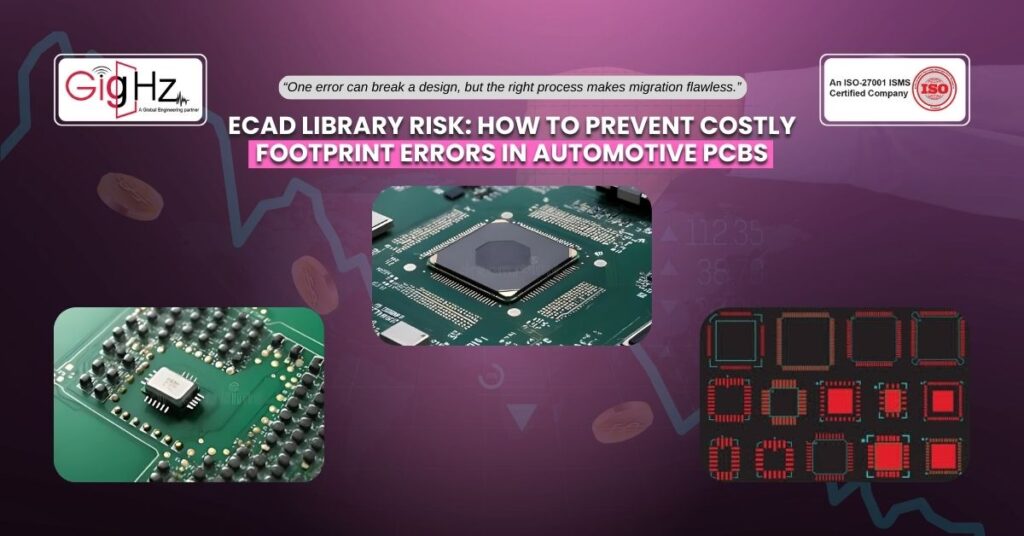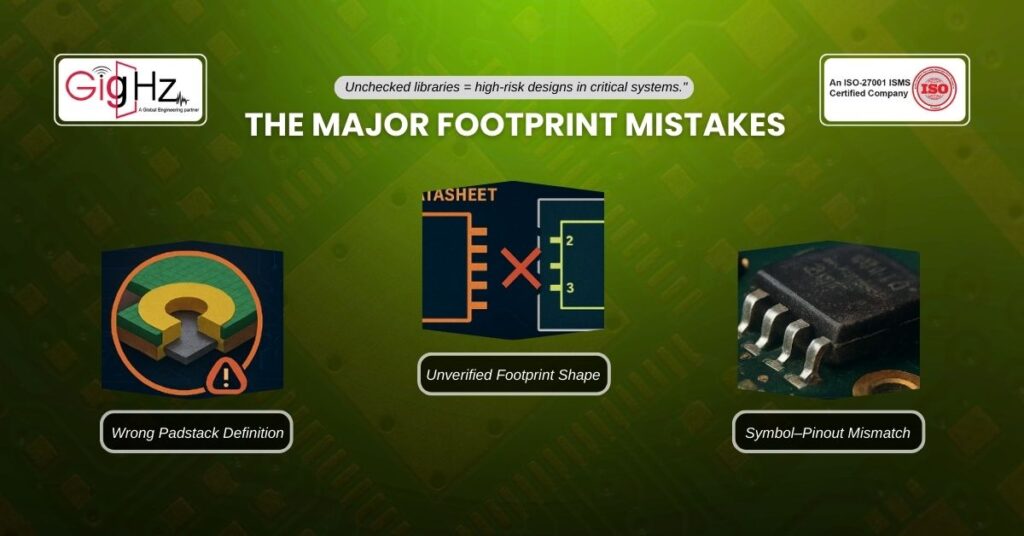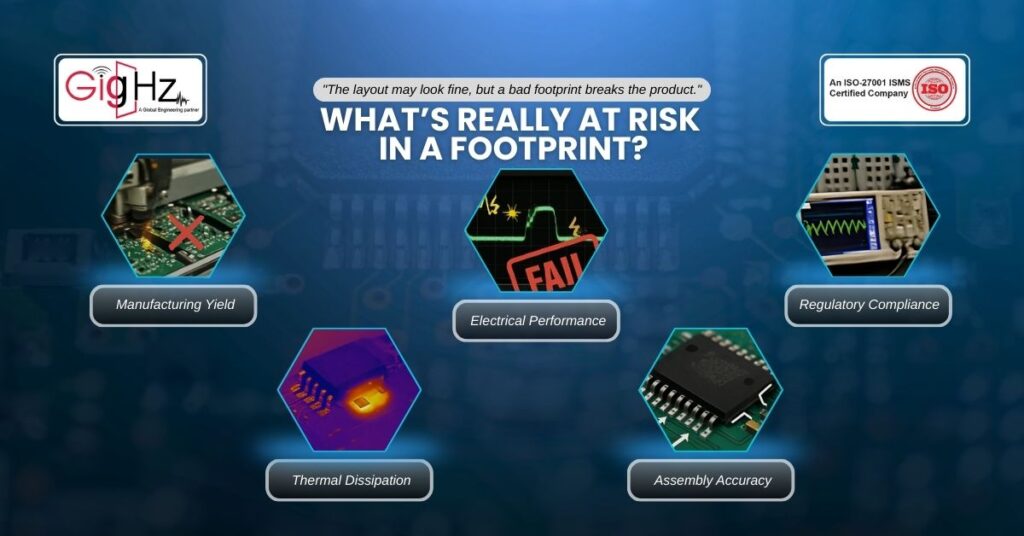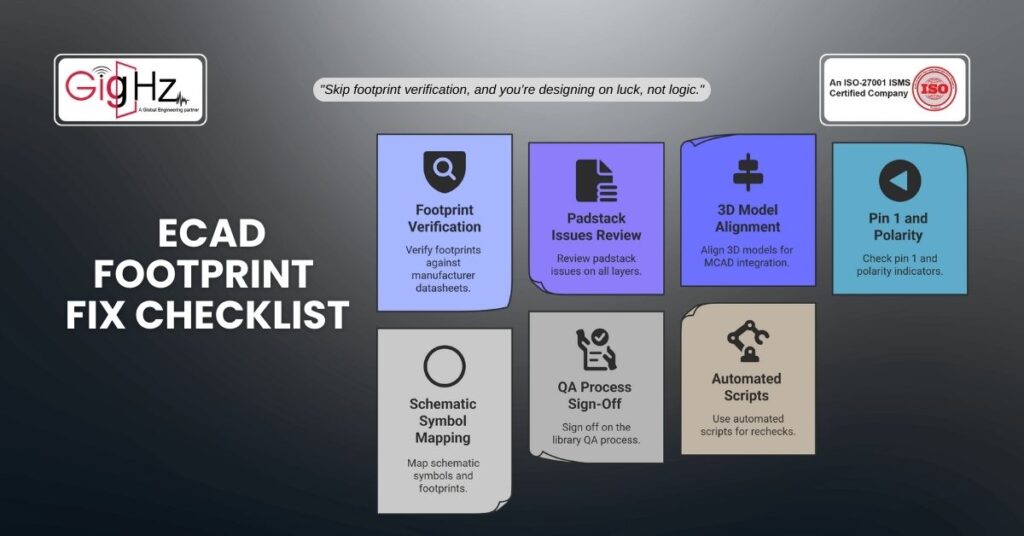ECAD Library Risk: How to Prevent Costly Footprint Errors in Automotive PCBs
- Posted On:
- September 15, 2025
- Category:
- Ecad

Well, it was just a pad! That too just a single one!
So, the board looked fine and the design passed the initial DRC.
Also, the prototype even powered up.
But one single misaligned pad in a critical IC footprint caused a full system failure after final assembly.
Consequently, the part overheated, the board failed up and the vehicle subsystem needed a complete redesign.
As a result, the total cost resulted in $2.5 million in losses!
Including recalls, retooling, and of course the re-engineering hours.
Apparently, this wasn’t a design error at all!
Neither, It was a schematic problem.
Rather, it was an ECAD library risk which something the team never saw coming.
The Major Footprint Mistakes

Now, for teams working in high-stakes industries like automotive, aerospace, and medical, the most dangerous errors are actually and always the quiet ones, like:
- A wrong padstack definition
- Then, an unverified footprint shape
- Mismatch between schematic symbols and layout pinouts
Circumstantially, these aren’t just nuisances. Instead, they are the hidden landmines that explode after you have already utilized your NRE budget.
And the worst part? Most ECAD teams don’t have a formal library QA process in place! Also, they just assume the libraries are fine until something breaks or completely falls apart.
Likewise, we have seen it firsthand: MSOP packages used with incorrect thermal pad sizes, or DFN packages where paste coverage was miscalculated—resulting in poor heat dissipation and, eventually, long-term device failure. Plus, these aren’t edge cases; they’re real consequences of skipping proper library validation.
What’s Really at Risk in a Footprint?

So, let’s bust a myth right now:
- “The footprint’s just a visual thing! And If the layout looks right then we are good.”
Completely Wrong! A footprint defines everything from solderability and thermal performance to testability and manufacturability.
So, here’s what a poor footprint can affect into:
- Manufacturing Yield
- Assembly Accuracy
- Thermal Dissipation
- Electrical Performance
- Regulatory Compliance
Of course, even safety as well to a great extent.
Hence, this is why footprint verification, padstack issues, and a bulletproof library QA process need to be top-notch in every ECAD team.
Our $2.5M Wake-Up Call
So, we were working with an EV startup scaling from prototype to pre-production phase. Now, their boards were functional and the schematics were tight. Additionally, the stackups were also reviewed beforehand.
But there was one issue!
Yes, a power FET footprint had a padstack mismatch between layers. Plus, the solder mask defined a larger opening than the copper which led to unreliable solder joints.
On the other hand, during thermal cycling, the connection had failed drastically. Also, in field testing, the board completely shut down under the immense load. Plus, the issue took weeks to trace because no one even suspected the library error at all.
So, what was the final fix? Well, it was one pad change.
And the final cost? Two and a half million dollars.
ECAD Footprint Fix Checklist
So, here’s the exact library QA process which we use at Gighz to protect clients from such terrible errors.
Accordingly, use this as your internal checklist before releasing any design to layout or production from now on.
1. Footprint Verification Against Manufacturer Datasheets

- Always cross-check every pad size, pin count, pitch, and mechanical outlines.
- No matter what! Don’t rely on community libraries or assumptions.
- Undoubtedly, use IPC-7351 as a guideline, but prioritize actual part dimensions.
Most importantly, a thorough footprint verification begins with datasheets — not just blindly trusting ECAD templates. You need to dig into the details: check tolerances, standoff heights, and land pattern recommendations. This becomes even more critical when dealing with parts that have multiple variants — like the same IC offered with and without an exposed thermal pad. Overlooking these nuances can lead to subtle, hard-to-debug issues down the line.
2. Padstack Issues Review (All Layers)
- Review pad size across all copper, paste, mask, and drill layers precisely.
- Thoroughly, check for annular ring violations.
- Evidently, validate thermal reliefs and via-in-pad behaviour.
Pro tip: Most padstack issues aren’t caught by basic DRC tools at all.
3. 3D Model Alignment (for MCAD Integration)
- Make sure the 3D body matches the actual component height and keep-out zone.
- Likewise, check pin orientation and polarity in 3D spaces.
Accordingly, this isn’t just for visuals only! Rather, it also matters for assembly and enclosure planning.
4. Pin 1 and Polarity Indicators
- Ensure proper polarity marking, especially on diodes, capacitors, and ICs.
- Then, cross-check both silkscreen and copper indicators.
Also, in automotive, polarity mistakes can lead to system-wide failures.
5. Schematic Symbol & Footprint Mapping
- Also, ensure every symbol is tied to the correct footprint with exact pin mapping.
- Additionally, check for invisible power pins or swapped pins in multi-gate components.
Because, one missed net here can definitely cascade into real-world circuit misbehaviors.
6. Library QA Process Sign-Off
- Implement a sign-off checklist per component.
- Version controls every footprint and padstack change.
- Document who approved what, and when.
Because, without a formal library QA process, your team is just hoping nothing breaks.
7. Automated Scripts for Rechecks
- Finally, use scripting or rule-based verification to catch inconsistencies at scale.
- Examples: mismatch between pad size and paste stencil, pinout mismatch with netlist, etc.
Consequently, this step is very crucial when working with hundreds of parts in complex boards.
Bottom Line
Remember, your library is either an asset or a liability!
When your team knows that every footprint has gone through rigorous footprint verification, that padstack issues are resolved, and that your library QA process is airtight… then they design faster and with more confidence.
Likewise, we at Gighz deliver verified, production-ready libraries tailored for a wide range of industries!
Moreover, our team uncovers the hidden risks in your existing library with precision—before they cost you heavily.
Stuck in a loop of challenges? Always pick smart solution that works
One wrong pad = millions lost. What’s your biggest footprint fear? lor
What’s your go-to shield against library risks?
Please answer both poll questions before submitting.
Thank you for your response! 😊
Latest Post
Get Customized Engineering CAD Design Service

Book a Free Consultation Call
Partner with Gighz and bring your most innovative design concepts to life. Our engineering cad services accelerate development so you can focus on your big vision.
